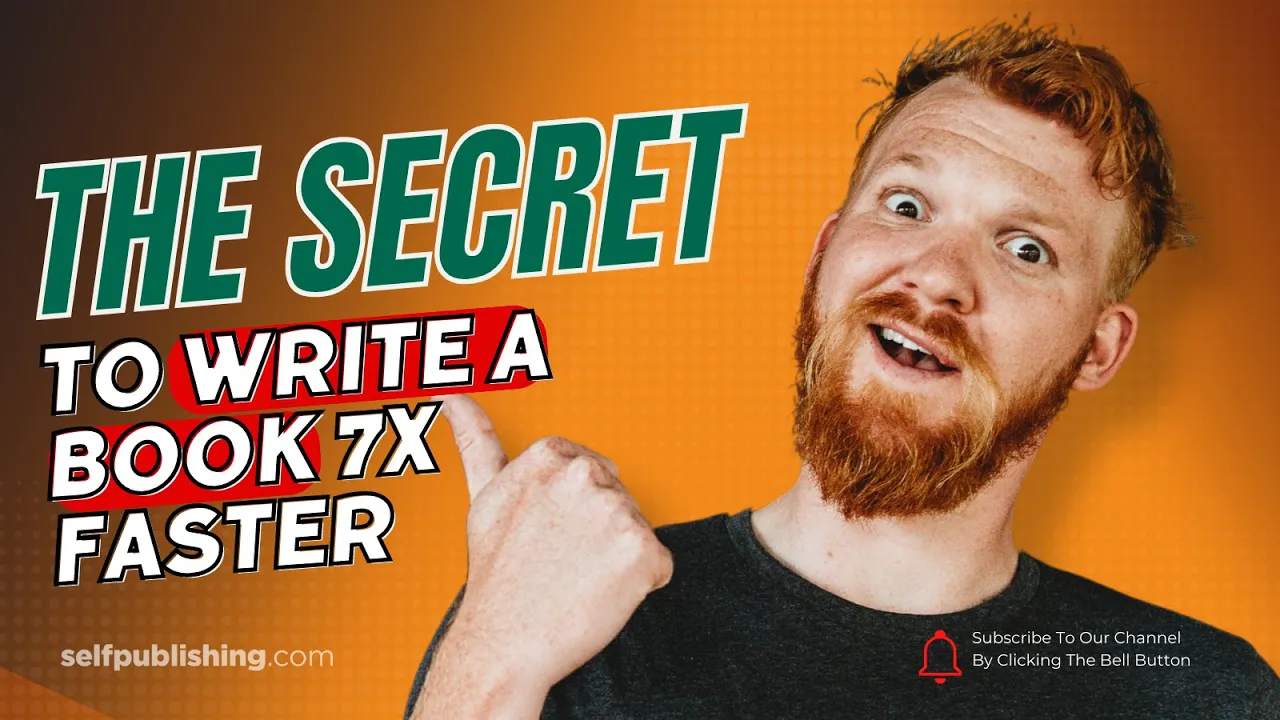Knowing how to copyright a book is an important step toward proper legal protection for every modern author – and one you shouldn’t shy away from.
No one wants to imagine their intellectual property being stolen, but it’s always a real possibility. However, by properly registering your work, you will be giving yourself – and your book – additional protection from any potential threats.
Learning how to copyright a book may feel like an intimidating process at first, but it doesn’t have to be!
In this complete guide on how to copyright a book, we’ll cover all of the details you need to know on how to create a copyright page, how long it takes to copyright a book, how to copyright a book for free, and more!
While we aren’t lawyers, this information is sourced through in-depth research, and from multi-published authors with direct experience in how to copyright a book.
The importance of learning how to copyright a book
Imagine you stumble upon a book with a similar title as yours online.
Curious as to what it’s about, you download the Kindle version and begin scrolling through the pages, and the content is very similar…no wait! It is almost identical to the book you launched just three months ago.
Now, if this were you, what would you do? Call the police? Report it to the bookstore? Call your mother?
This kind of situation is more common than you think, and it could very well happen to you. But there are simple steps you can take to protect your work by educating yourself on how to copyright a book.
Learning how to write your book is just one side of the equation to become an author.
You also have to navigate some tricky technical aspects. As a creative, you are a potential target for content thieves. You have to protect your material and the best way to do this is to learn how to copyright a book.
What is copyright law?
Copyright law refers to when you ‘legally register your work with a government body in order to create a public record that proves you are the legal owner of this work.’
Learning how to copyright a book is an important step. Copyright law is set up to protect your rights, and also to ensure that you are aware of the rights of others’ work.
Copyright law terminology
Let’s break down some of the legal jargon that surrounds copyright law.
In order to understand the process of how to copyright a book, you need to know the basics: the commonly used words, and what they mean.
These are the most commonly used legal terms for book copyright:
- Copyright term: The current length of copyright for an individual is the life of the author, plus 70 years. For corporate works, the term is 95 years from first publication or 120 years from creation, whichever happens first.
- Plagiarism: The “wrongful appropriation” and “stealing and publication” of another author’s “language, thoughts, ideas, or expressions” and the representation of them as one’s own original work. This is true if you plagiarize from a book, a college paper, or “borrow” from an article and call it your own. It is an act of intellectual dishonesty.
- Copyright infringement: The use of works protected by copyright law without permission, infringing certain exclusive rights granted to the copyright holder, such as the right to reproduce, distribute, display or perform the protected work, or to make derivative works. The copyright holder is typically the work’s creator, or a publisher or other business to whom copyright has been assigned. Copyright holders routinely invoke legal and technological measures to prevent and penalize copyright infringement.
- Public domain: The public domain includes creative works that are not subject to copyright because their copyright has expired, as well as aspects of copyrighted works–such as their underlying ideas–that are not subject to copyright. The public domain is a critical source of creativity, inspiration, and innovation for creators. Works and ideas in the public domain belong to the public and their use does not violate copyright.
- Fair use: Fair use is a critical right that permits the public to use portions of copyrighted material without permission from the copyright owner, under certain circumstances, to engage in a wide variety of vital activities. It enables new technologies and is a cornerstone of free speech, creativity, and the economy.
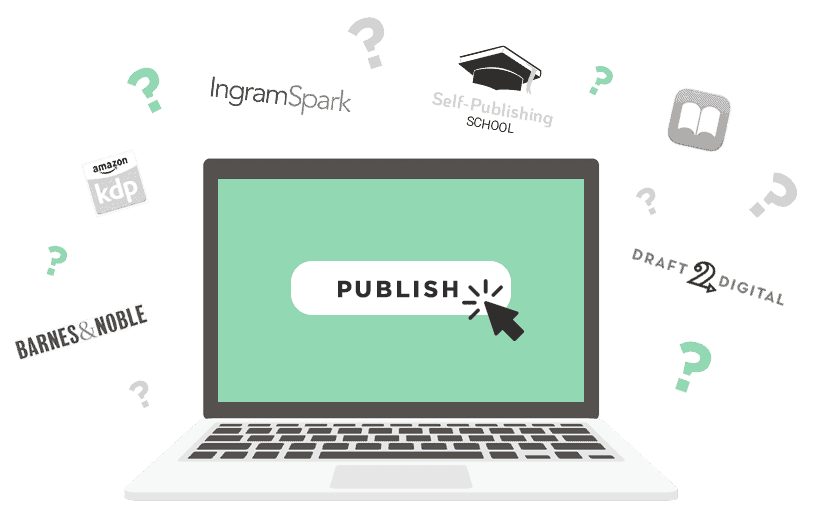
- Digital Millennium Copyright Act (DMCA): The DMCA is a 1998 United States copyright law that implements two 1996 treaties of the World Intellectual Property Organization (WIPO). It criminalizes the production and dissemination of technology, devices, or services intended to circumvent measures that control access to copyrighted works (commonly known as digital rights management or DRM). It also criminalizes the act of circumventing access control, whether or not there is actual infringement of copyright itself.
- The Library of Congress Classification (LCC): A classification system that was first developed in the late nineteenth and early twentieth centuries to organize and arrange the book collections of the Library of Congress. Over the course of the twentieth century, the system was adopted for use by other libraries as well, especially large academic libraries in the United States. It is currently one of the most widely used library classification systems in the world.
- Copyright Office: Housed within the Library of Congress, it is the official United States government body that maintains records of copyright registrations, and provides legal advice to Congress, the Judiciary, and federal agencies.
- Statutory definition (from the official website Copyright.gov portal): The Copyright Act defines “literary works” as “works, other than audiovisual works, expressed in words, numbers, or other verbal or numerical symbols or indicia, regardless of the nature of the material objects, such as books, periodicals, manuscripts, phone records, film, tapes, disks, or cards, in which they are embodied.”
- Intellectual property (or “IP”): A category of property that includes intangible creations of the human intellect, and primarily encompasses copyrights, patents, and trademarks. It also includes other types of rights, such as trade secrets, publicity rights, moral rights, and rights against unfair competition. Artistic works like music and literature, as well as some discoveries, inventions, words, phrases, symbols, and designs can all be protected as intellectual property.
- Copyright lawyer: A lawyer who specializes in copyright law and will represent you when someone else is using your idea or content without your permission, especially for financial gain. They can also defend you if you’re accused of infringement.
Should I copyright my book?
Yes, you should learn how to copyright a book to protect your intellectual property.
There are people out there who will woefully take your work, slap a different title on it, change some names around, and release it as their own. Yes, it does happen, and in the digital age, it is happening more often. Some authors have had an entire series of books stolen and sold in other countries.
The truth is, there are publishing scams and people who can (and will) rip off your work and try to sell it as their own.
So, you heard it from us: You want to learn how to copyright a book legally. While it is a fact that your writing is technically copyrighted the minute you put words to paper, in order to take action against someone in a court of law, you must register it with the copyright agency. No exceptions.
So, without further ado, let’s discuss how to copyright a book.
How to copyright a book in 10 minutes: a step-by-step guide
Learning how to copyright a book isn’t that complicated. You can do this in 15-20 minutes simply by registering with the Copyright Office.
There are two ways you can apply for your copyright.
- Filling out the forms by hand and delivering them directly to the Copyright Office via snail mail, or
- Setting up an account online with the US Copyright Offices’ eCo (Electronic Copyright Office) and doing everything online. The cost is slightly cheaper if you take this route.
Here are steps for how to copyright a book online:
Step 1: Go to the Copyright Office registration portal using the link above.
Step 2: Scroll down to “Types of Works” and click on “Learn more” under “Literary Works” (it is the first image box).
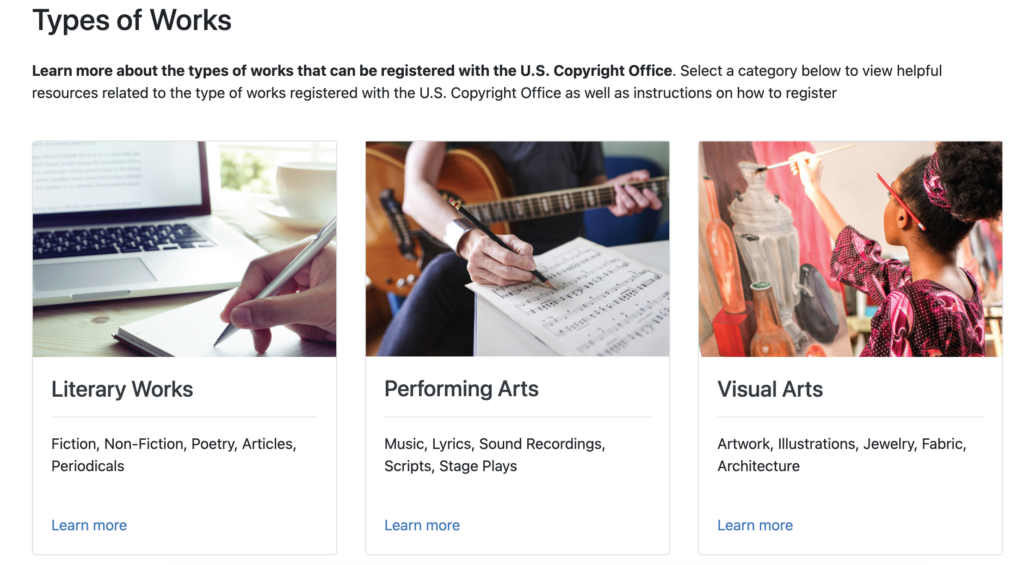
Step 3: Click on the “Register a Literary Work” link under the photo.
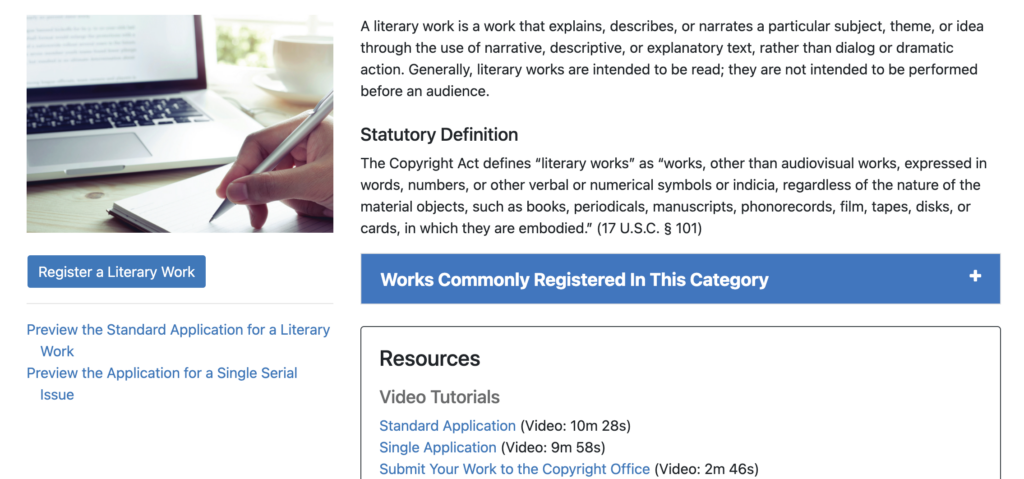
Step 4: Log in to your existing account or register as a new user.
Step 5: Once you’re signed in, click “Standard Application”. Check the “Exceptions” section below to be sure you are registering the right kind of work.
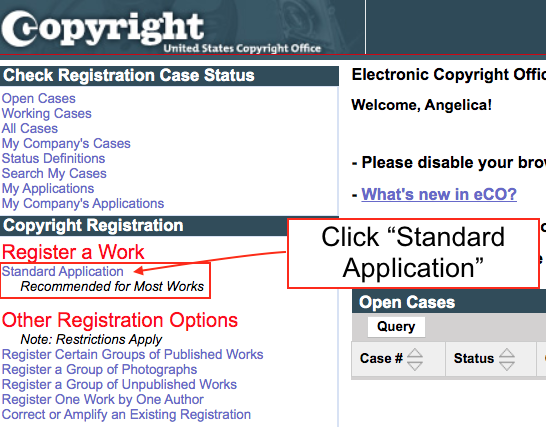
Step 6: Click “Start Registration.”
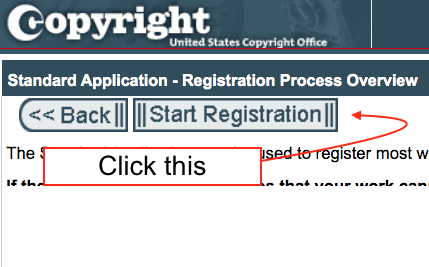
Step 7: Select the “Type of Work”, which is “Literary Work” if registering your book.
Note: This cannot be changed after you confirm what you are registering. Check the box to acknowledge this, then click “Continue.”
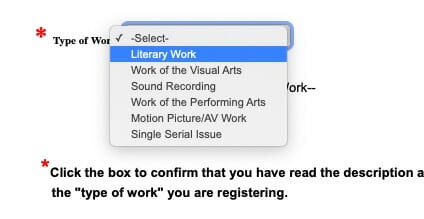
Step 8: Click “New*.”
Step 9: Select your Title Type, then enter your Book Title exactly as it appears on your book cover/title page.
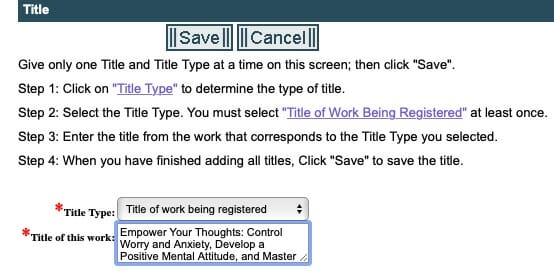
Step 10: Click “Save” to save your title. Then, on the next page, click “Continue” to move on to the next step.
Step 11: Select “Yes” or “No” if this work has already been published (or not).
Step 12: Enter the required information in the “Publication/Completion” form, then click “Continue.”

Step 13: Name the author(s) of the work being registered.
After you enter the author information, click “Save”. Fill out the rest of the information that includes “date of birth”, “citizenship”, and “domicile.”
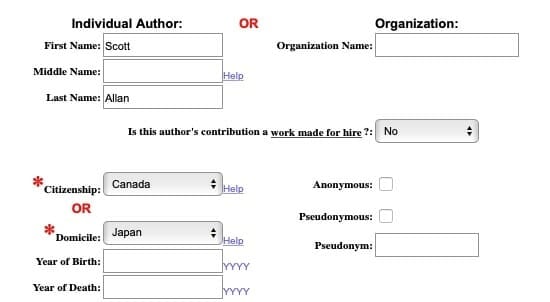
Repeat this step for each additional author. Click “Save” to move into the next step.
Step 14: Under “Author’s Contribution,” for a book just select “text” and “Save.”
Step 15: Identify the Copyright Claimant(s) in this work.
If this is you, the author, you are the original claimant of your work. You own all of the claimants as covered by the registration. Click “add me” as the claimant. Then, on the next page, click “Continue.”
Step 16: Limitation of Claim: If your work does not contain any preexisting material, click “Continue” to proceed to the Rights and Permissions Screen.
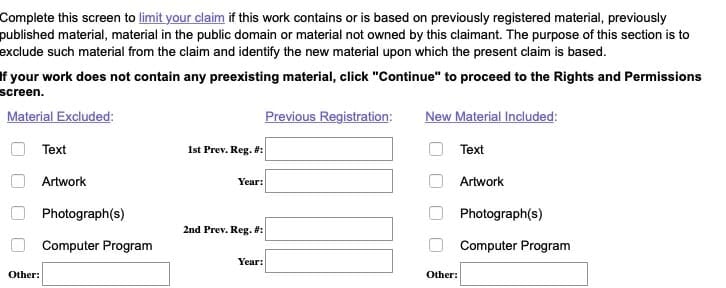
Step 17: Rights and Permissions Information (Optional): If someone is managing your rights and permissions, fill in their information here. If not, just click “Continue.”
Step 18: Correspondent: This is the person the Copyright Office will contact if it has questions about this application. If you are the only contact, you can click on “Add Me” and your contact information will be filled in.
Step 19: Mail Certificate: This is the name and address to which the registration certificate should be mailed. After you complete the registration, you will receive by post a letter of confirmation stating that your book has been officially registered. Keep this certificate with your important documents in case needed. You can click “Add Me” and your information will be automatically updated in the boxes. Click “Continue”.
Step 20: Special Handling: This is for shipping purposes. It is expensive so if that is a concern, skip this part by clicking on “Continue”.
Step 21: Certification: The application must be certified by the author, copyright claimant, or owner of exclusive right(s), or by the authorized agent of any of the preceding. In this section, you are stating that you are, in fact, the owner of the material as it is being registered.
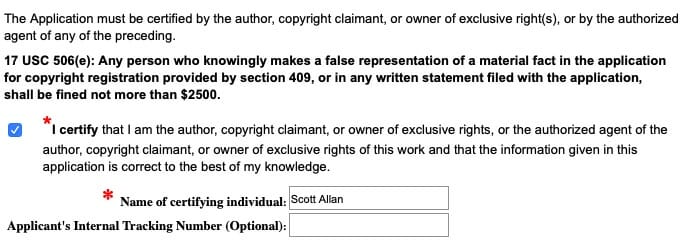
Click “Continue” to move to the last section.
Step 22: Review Submission: Review everything and double-check your details. Note: Once you submit your application, you cannot make changes to it. So be sure it is all correct!
When the entire submission is correct, click the “Add to Cart” button at the top of the screen.
Step 23: Checkout: You’re almost there, click the “Checkout” button. On the next page, you are prompted to hit the “OK” button if you agree to these terms: Payments are non-refundable.
Step 24: Copyright Fee Services: You can pay either with credit/debit card or through a bank transfer. The fee is $55.00 for a single registration when you use the eCo system.
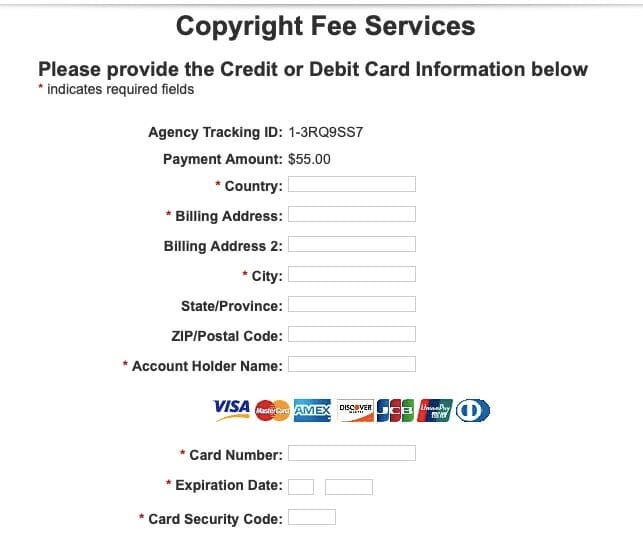
Step 25: Submit Your Work: You have two options here—You can upload the digital version of your book, or, send in the paperback. For a faster process, upload your digital eBook version. You can only choose one of these options.
Then, you’re done! If your payment has been accepted, your book is now registered with the U.S. Copyright Agency. The Office will issue a certificate to your home address after the application has been processed. This can take as long as one year, but with most of my books, I received the certificate within three months.
Step 26: (if applicable) Submission by Post: To send in your book by mail, follow the instructions on the submission page.
The application process can take months, but your work is accepted and legally copyrighted the instant you send in your application.
Now you know how to copyright a book. Done!
It is worth noting that you do have the option to register your book before it gets published, but it isn’t a necessary step.
Some authors are worried that the editor they just hired online is going to make away with their work. That rarely happens. It could, but chances are, if you have done your research and hired your editor through a reputable agency, you have nothing to worry about.
Besides, remember what I said at the beginning of this post: Your work is copyrighted the moment you write it. Would this stop someone from stealing it? No, but you always have digital proof that it is your intellectual property.
Now that you know how to copyright a book, let’s move to the next important stage of copyrighting: creating a book copyright page.
How to create a book copyright page
Every book needs to have a copyright page. Depending on the type of book you are writing, your copyright page will vary in format and style.
A copyright page appears in your book right after the Book Title page and before the Table of Contents.
You might be thinking, “What do I place on the copyright page?”
I know, it looks like a combination of legal jargon with numbers – and can be confusing for a first-time author who has never created one before.
But the good news is, you don’t have to create anything. Most copyright pages are standard in the language they use, and there are plenty of copyright page templates to use depending on the type of page you need.
In order for your book to be “copyrighted,” your copyright page should include several essential components.
Here are the copyright elements to include in your copyright page:
- Copyright notice
- Year of publication
- Author’s name
- Edition information
- Publication information
- Printing history
- Cataloging data
- Legal notices
- Credits to the book
- ISBN
- Website address
- Disclaimer (if applicable)
Now that we’ve identified which elements to include in your copyright page, let’s break down the process of creating a copyright page specifically if you are learning how to self-publish a book.
How to create a copyright page for a self-published book
- Add the copyright notice.
- Include the edition information.
- Reserve your book rights.
- Add the book ISBN.
- Include a website address.
- Give credit to any contributors.
Let’s break each of these steps for how to copyright a book below:
Add the copyright notice
This is the most important element on the book copyright page. It consists of three parts:
- The © symbol, or the word “Copyright”
- The year of first publication of the work
- Identification of the owner of the copyright—by name, pseudonym, abbreviation, or some other way that it’s generally known
Example: © 2020 by Scott Allan
Include the edition information
If this is a 2nd or 3rd edition, you want to include this here. Many books include this on the cover or title page, too. Even if it is stated elsewhere, it needs to be on the copyright page.
Reserve your book rights
This may also be referred to as the disclaimer portion of the copyright page. You can copy this portion and use it for your own book:
“All rights reserved. No part of this publication may be reproduced, distributed or transmitted in any form or by any means, including photocopying, recording, or other electronic or mechanical methods, without the prior written permission of the publisher, except in the case of brief quotations embodied in critical reviews and certain other noncommercial uses permitted by copyright law.
While all attempts have been made to verify the information provided in this publication, neither the author nor the publisher assumes any responsibility for errors, omissions, or contrary interpretations of the subject matter herein.
Adherence to all applicable laws and regulations, including international, federal, state, and local governing professional licensing, business practices, advertising, and all other aspects of doing business in the US, Canada, or any other jurisdiction is the sole responsibility of the purchaser or reader.
Any perceived slight of any individual or organization is purely unintentional.”
Add the ISBN number
If you publish a paperback book, you need an ISBN number. You can purchase your ISBN at: https://www.myidentifiers.com/
Your digital book (eBook) does not require an ISBN, but many publishers include an ISBN anyway, in order to publish with self-publishing companies outside of Amazon. This prevents multiple ISBNs from being issued to one book.
Include a website address (optional)
While this is an optional step, it may be important to include if you are looking to grow your email list or capture leads from your book.
Make it easy for your readers to find you. Include your link showcasing your website.
Give credit to contributors (optional)
In this section, you can name the people who helped you on the project. Your cover designer, editor, illustrator, or interior formatter.
Your copyright page can be simple, too. Many books have one page with all of the information listed above. You don’t need a long copyright page. All you need is the copyright notice and a statement that the rights to reproduce the work are reserved for the copyright holder. That’s it!
Here’s a short copyright page from Motivation Without the Hype by Gez Perez. It includes all the necessary elements to satisfy the copyright.
Book copyright page disclaimers
Writing a disclaimer is an essential piece of learning how to copyright a book. A disclaimer protects you from the actions people take based on your advice.
A disclaimer sounds boring and most readers are tempted to skip it. But it serves as an anchor for your protection and informing people, “Try this at your own risk.”
The type of copyright disclaimer you publish will vary depending on your book’s content. A disclaimer for fiction would be different from a disclaimer for health and fitness.
Your readers will trust most of what you say, and your suggestions have influence. But you must exercise caution. To avoid liability, a disclaimer is needed. This is true for fiction as much as it is for nonfiction.
Fiction disclaimer example:
Here is a sample of fiction disclaimer from Ramy Vance’s Mortality Bites Series.
Nonfiction disclaimer example:
This is a standard nonfiction disclaimer found in most books. If you are a professional counselor, doctor, therapist, personal development coach, or in a position when providing advice or consulting, you need an extended disclaimer.
This goes beyond the general “content protection” verbiage and targets you on a more personal level.
Here is a short sample:
The advice and strategies found within may not be suitable for every situation. This work is sold with the understanding that neither the author nor the publisher are held responsible for the results accrued from the advice in this book. You should consult with a (lawyer, health professional, financial advisor) for further details and future actions.
FAQs about how to copyright a book
In this section, we’ll cover the most frequently asked questions about how to copyright a book. We also encourage you to check out our resources section below if you want to dive in deeper to any specific topic related to your copyright questions.
How do you copyright a book title?
Want to know how to copyright a book title? Your book title is copyrighted the moment you write it, but for extra piece of mind, you can officially copyright your book title when you register your completed book with the U.S. Copyright Office.
While there isn’t necessarily a way to copyright only your book title without having to upload your completed book, your book title will be copyrighted once you complete the book copyright process that we walked you through in the steps above.
How do you copyright a book idea?
If you have not published your book yet, you can still register your copyright. You will be able to register your copyright before publishing your book.
Some authors choose to do this for extra protection, especially those who work with editors and other book service providers, to prevent anyone from stealing their book’s contents or ideas.
If you’re concerned about protecting your book idea and want to copyright it before you publish, go for it. You can use the steps listed above to learn how to copyright a book – before it is even published.
How long does it take to copyright a book?
Once you have registered your book for copyright, the processing times will vary depending on the type of work you submitted and the way in which you submitted it.
On average, if you register your copyright online, it typically takes about three months, but can take up to six months.
If you register your book’s copyright via standard mail, it takes an average of six months but can take up to 16 months.
How much does it cost to copyright a book?
It costs $55 to register a single book copyright with the eCo system using the steps we indicated above. You can pay online with a credit/debit card or through a bank transfer.
For online processing, the fee can be $35 or $55.00 for a single basic online registration. For standard mail processing, the fee is $85.00.
How do you copyright a book for free?
Want to know how to copyright a book for free? Your book is technically copyrighted for free the moment you create it, just as if it were any other work of art. However, many authors seek more copyright protection and choose to pay the fee to officially register a book copyright.
If you do not want to pay the fee to register a book copyright, and do not need the legal peace of mind that comes with officially registering a copyright, then you can learn how to copyright a book for free very simply – just by writing it yourself!
How do I copyright a book internationally?
In the United States, as we have just looked at, you go through the U.S. Copyright Office for all matters related to how to copyright a book (and other copyrighting-related formats). Your book must be registered first with this office before any legal action can be pursued.
But, how are you protected if you are an author or publisher living in Germany, Canada, Japan, or the U.K.?
If you visit the WIPO (World Intellectual Property Organization), you can find everything you need to know through the Berne Convention for the Protection of Literary and Artistic Works.
With most countries in the world, your work is protected from the moment you create it in a format that is “perceptible either directly or with the aid of a machine or device, according to the United States Copyright Office under Copyright In General.” But you do have to register first in order to bring a lawsuit to court.
As most countries are protected under the Berne Convention, it should be an easy process to register your works online in most countries. This may vary depending on local regulations and procedures.
In the UK, consult with the Intellectual Property Office in the United Kingdom. There is no official registration system in place for copyrighting works, and is considered an “automatic right.”
In Canada, visit the Canadian Intellectual Property Office to register your copyright.
When in doubt, you can visit the WIPO site and under Country Profiles, find the directory for the copyright office to apply to.
What do I need copyright permission for?
One of the more common questions that comes up with how to copyright a book is, “Do I need permission to borrow this published content?” This is sometimes not as obvious as copying something right out of a book or published manuscript.
To help you answer this question, “Do I need copyright permission?” we suggest you visit Wiley.com. This site provides you with everything you need to know.
Wiley has an extensive and reliable list to guide you through the content and material you must seek permission for. But they also include a sample permission request form in order to apply for permission.
When in doubt, consult with a copyright lawyer and take the time to research the material you are either protecting or, planning to borrow from another source. The time invested could save you an expensive situation later on.
As an author in the publishing business, you have to protect your business, assets, and customers. Be smart and don’t cut any corners. You wouldn’t want to sabotage your work, name, and business you’ve worked so hard for.
Book copyright resources
We want you to be able to find everything you need to learn how to copyright a book. Here we have compiled a list of resources so you can quickly find the information you are looking for.
Learn more about book copyright from these resources:
Take action: copyright your book today!
Now that you know how to copyright a book, jump over to Copyright.gov and complete the process in less than 20 minutes.
When in doubt, consult with legal counsel. The time invested could save you a costly situation down the road.
If you want to follow a proven framework for how to successfully write and publish your book without having to stumble through the process, consider investing in a self-publishing course for support.
When you become an author, you want your book launch to go off without any surprises, so education is your key to success.

